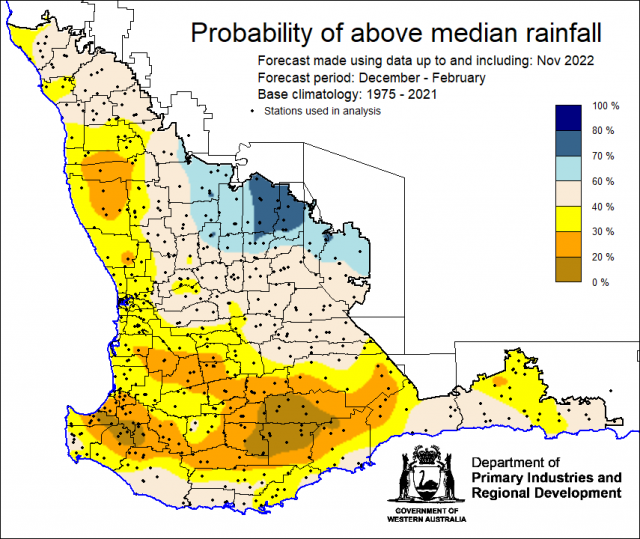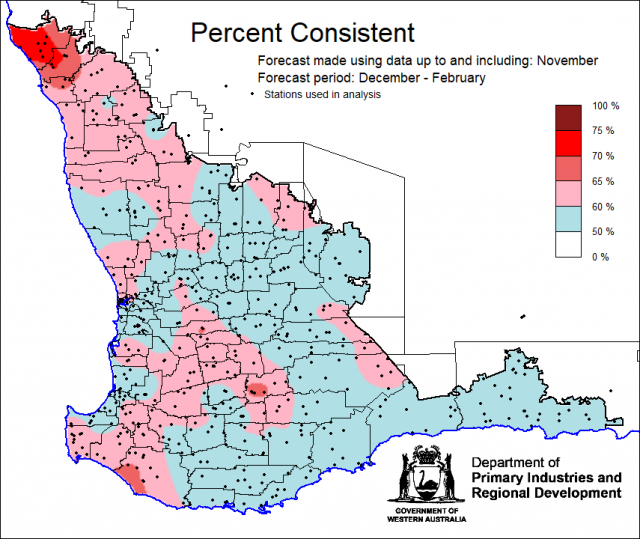Summary
The Department of Primary Industries and Regional Development’s (DPIRD) Statistical Seasonal Forecast (SSF) outlook for summer, December 2022 to February 2023, is indicating less than 40% probability of above median rainfall for the majority of the South West Land Division.
- For summer, December 2022 to February 2023, the SSF forecast is indicating below 40% probability of above median rainfall for the majority of the South West Land Division. Above 60% probability for part of the Central Wheatbelt forecast district. The most likely decile range map is indicating decile 2-3 for the majority of the SWLD, with decile 8-10 for part of the Central Wheatbelt forecast district. Skill is mostly poor at 50 to 75% consistent.
- The Bureau of Meteorology’s seasonal outlook for December 2022 to February 2023 is indicating 25-50% chance of exceeding median rainfall for the SWLD, with moderate to good skill (55-75%). The current longer-term outlook (at time of writing) for January to March 2023 is 30-50% chance of exceeding median rainfall with mostly moderate skill (50-65%).
- Temperature outlooks for December 2022 to February 2023, from the Bureau indicate a 30-80% chance of above average day-time maxima, with the lower chances along the south coast. Skill is moderate 65-75%. For night-time minima for the SWLD, the Bureau is indicating 50-75% chance of exceeding above average temperatures, with the higher chances along the coast. Skill is moderate to good at 55-100%.
- November rainfall was above average along the south coast and Central Wheatbelt with reports of hail and fires after a series of thunderstorms. November maximum temperatures were below average to very much below average. Minimum temperatures were below average to average
- In the next couple of months, the warmer sea surface temperatures north of Australia increases the likelihood of tropical cyclones developing. In La Niña years, the first Australian tropical cyclone to make land fall is about 3 weeks earlier than in a neutral ENSO year. Summer rainfall in the SWLD are usually caused by isolated thunderstorms and tropical cyclones and are therefore harder to (long-lead) forecast, than winter rainfall which are mostly from westerly frontal systems.
Three Month Outlook for the south-west of Western Australia
Statistical Seasonal Forecasting (SSF)
DPIRD’s Statistical Seasonal Forecast (SSF) system uses historical relationships between global sea surface temperature and sea level pressure with rainfall in south-west Australia to produce forecasts of rainfall for the coming months. Users can click on any station indicated on the map for location-specific forecast information from DPIRD’s Seasonal Climate Information pages.
For December 2022 to February 2023, the SSF forecast is indicating below 40% probability of above median rainfall for the majority of the South West Land Division. Above 60% probability for part of the Central Wheatbelt forecast district. The most likely decile range map is indicating decile 2-3 for the majority of the SWLD, with decile 8-10 for part of the Central Wheatbelt forecast district. Skill is mostly poor at 50 to 75% consistent.


